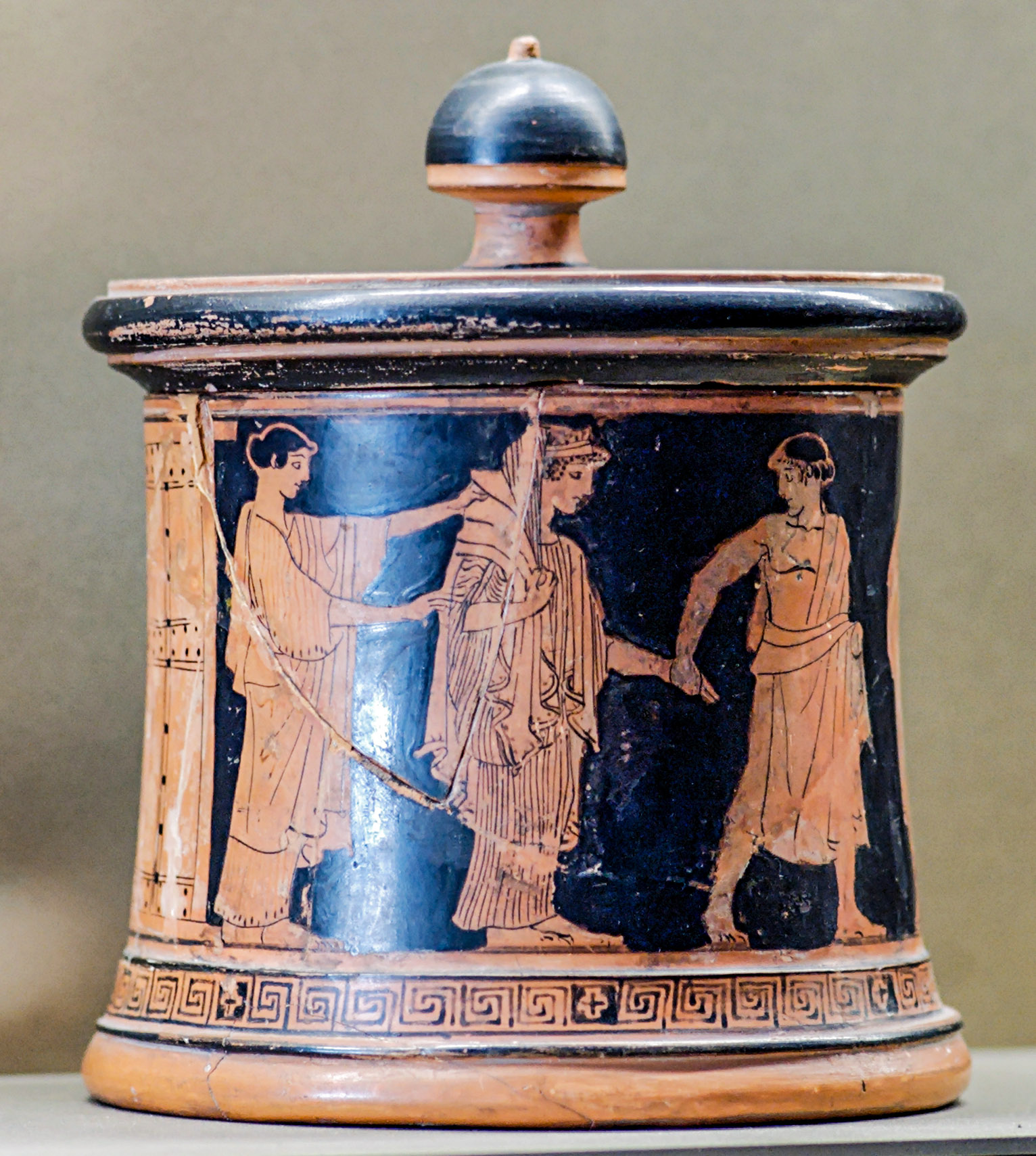Pyxis (vessel) on:
[Wikipedia]
[Google]
[Amazon]
 A ''pyxis'' (, plural ''pyxides'') is a shape of vessel from the classical world, usually a cylindrical box with a separate lid. Originally mostly used by women to hold cosmetics, trinkets or jewellery, surviving ''pyxides'' are mostly Greek pottery, but especially in later periods may be in wood, metal,
A ''pyxis'' (, plural ''pyxides'') is a shape of vessel from the classical world, usually a cylindrical box with a separate lid. Originally mostly used by women to hold cosmetics, trinkets or jewellery, surviving ''pyxides'' are mostly Greek pottery, but especially in later periods may be in wood, metal,
File:Pisside con rilievi in faience, da polledrara, vulci, 750-700 ac ca. 01.JPG, Pyxis made out of "
{{Greek vase shapes
Ancient Greek pot shapes
Containers
 A ''pyxis'' (, plural ''pyxides'') is a shape of vessel from the classical world, usually a cylindrical box with a separate lid. Originally mostly used by women to hold cosmetics, trinkets or jewellery, surviving ''pyxides'' are mostly Greek pottery, but especially in later periods may be in wood, metal,
A ''pyxis'' (, plural ''pyxides'') is a shape of vessel from the classical world, usually a cylindrical box with a separate lid. Originally mostly used by women to hold cosmetics, trinkets or jewellery, surviving ''pyxides'' are mostly Greek pottery, but especially in later periods may be in wood, metal, ivory
Ivory is a hard, white material from the tusks (traditionally from elephants) and teeth of animals, that consists mainly of dentine, one of the physical structures of teeth and tusks. The chemical structure of the teeth and tusks of mammals i ...
, or other materials. The name derived from Corinthian Corinthian or Corinthians may refer to:
*Several Pauline epistles, books of the New Testament of the Bible:
**First Epistle to the Corinthians
**Second Epistle to the Corinthians
**Third Epistle to the Corinthians (Orthodox)
*A demonym relating to ...
boxes made of wood from the tree ''puksos'' (boxwood
''Buxus'' is a genus of about seventy species in the family Buxaceae. Common names include box or boxwood.
The boxes are native to western and southern Europe, southwest, southern and eastern Asia, Africa, Madagascar, northernmost South ...
), that also came with covers. The shape of the vessel can be traced in pottery back to the Protogeometric period in Athens, however the Athenian ''pyxis'' has various shapes itself.
At first, the two varieties of ''pyxis'' included the pointed and the flat-bottomed. The pointed ''pyxis'' didn't last much longer than the ninth century BCE, while the flat-bottomed continued into the late Geometric. It also continued to grow larger and more squat in proportions. The cover often depicts elaborately sculpted handles and the walls tend to be somewhat convex. During the sixth century BCE, Athens began producing boxes with concave walls that enabled them to be grasped easily when arranged close together on a shelf. Compare the waisted shape of the medieval and Early Modern albarello
An albarello (plural: ''albarelli'') is a type of maiolica earthenware jar, originally a medicinal jar designed to hold apothecaries' ointments and dry drugs. The development of this type of pharmacy jar had its roots in the Middle East during ...
. Images on the ''pyxis'' usually depict the marriage procession from a young girl's house to that of her new husband.
Pyx is a term for a specifically liturgical
Liturgy is the customary public ritual of worship performed by a religious group. ''Liturgy'' can also be used to refer specifically to public worship by Christians. As a religious phenomenon, liturgy represents a communal response to and partic ...
box, usually cylindrical, but of variable design, still used for holding and transporting consecrated hosts in the traditional Christian churches, a use to which the church began to put these boxes at a very early date.
Gallery
Egyptian faience
Egyptian faience is a sintered- quartz ceramic material from Ancient Egypt. The sintering process "covered he materialwith a true vitreous coating" as the quartz underwent vitrification, creating a bright lustre of various colours "usually ...
". Imported to Italy from northern Syria. Produced 750-700 BC., Altes Museum
File:Byzantine - Circular Pyxis - Walters 7164 - View A.jpg, Circular pyxis, 5th Century, The Walters Art Museum
The Walters Art Museum, located in Mount Vernon-Belvedere, Baltimore, Maryland, United States, is a public art museum founded and opened in 1934. It holds collections established during the mid-19th century. The museum's collection was amassed ...
File:Roman - Pyxis - Walters 4776 - View B.jpg, An exquisite example of Roman luxury glassware, used to hold cosmetics or precious jewellery
File:Pyxis with four horses, Greece, Attica, Geometric Period, 8th century BC, terracotta - Wadsworth Atheneum - Hartford, CT - DSC05138.jpg, Horse pyxis
File:Athens_Pyxis_depicting_a_hand.jpg, 4th century Athenian ''pyxis'' with a depiction of a hand, National Museum in Warsaw
The National Museum in Warsaw ( pl, Muzeum Narodowe w Warszawie), popularly abbreviated as MNW, is a national museum in Warsaw, one of the largest museums in Poland and the largest in the capital. It comprises a rich collection of ancient art ( Eg ...
File:Ivory Pyxis from Cordoba.JPG, Ivory pyxis from Cordoba, Spain, 10th Century AD, Victoria and Albert Museum
The Victoria and Albert Museum (often abbreviated as the V&A) in London is the world's largest museum of applied arts, decorative arts and design, housing a permanent collection of over 2.27 million objects. It was founded in 1852 and nam ...
File:Pyxis_ECII_NAMA_080763.jpg, Spool-shaped pyxis (NAMA 5225)